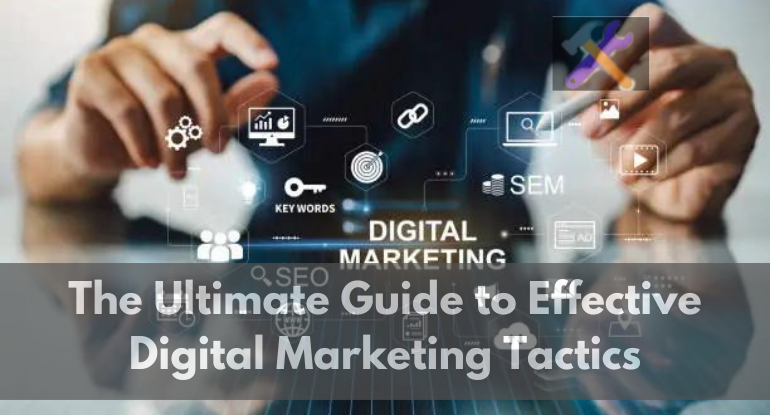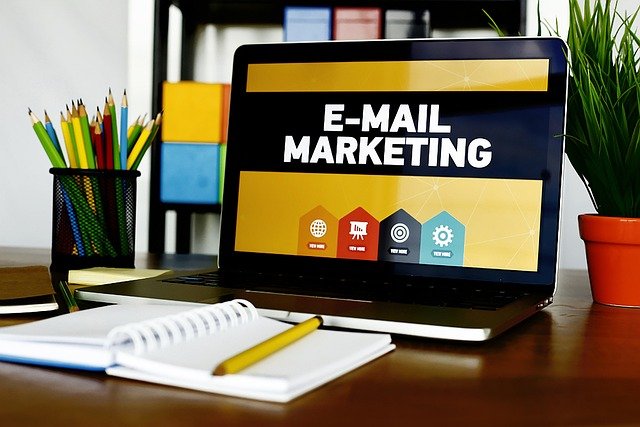
The Ultimate Guide to Effective Digital Marketing Tactics
Effective digital marketing is vital for the success and growth of any business in today's fast-paced digital landscape . With numerous platforms, tools, and strategies available, it can be overwhelming to navigate and choose the most effective tactics for your specific goals.
This guide aims to provide a comprehensive overview of some proven digital marketing tactics to help you achieve your marketing objectives and stay ahead in the competitive online market.
Search Engine Optimization (SEO)

SEO, standing as the cornerstone of successful digital marketing strategies, plays an indispensable role in enhancing online visibility and driving organic traffic to websites. It encompasses a comprehensive array of practices aimed at optimizing your website to rank higher in search engine results.
These strategies effectively position your brand and content in front of potential customers, leading to increased brand exposure and higher chances of conversion.
#1. Thorough Keyword Research and Analysis: Conducting extensive keyword research is the foundational step in SEO. Identify and analyze relevant keywords related to your industry, products, or services.
This research aids in understanding the language and terms potential customers use when searching for information related to your business.
#2. On-Page Optimization: On-page optimization involves optimizing various elements on your website to improve its visibility and relevance to search engines. This includes optimizing meta tags, headings, content, images, and URL structures.
By aligning these elements with targeted keywords, search engines can better understand the content and purpose of each page.
#3. Content and Structure Optimization: Optimize your website's content and structure to make it easily indexable and readable by search engines. Develop high-quality, informative, and engaging content that resonates with your target audience.
Organize the content in a logical structure with proper headings and subheadings, facilitating both user navigation and search engine understanding.
#4. Backlink Building: Building high-quality backlinks from reputable and relevant websites is vital for enhancing your site's authority and credibility. Backlinks act as "votes of confidence" from other websites, signaling to search engines that your content is valuable and trustworthy.
Aim to acquire backlinks from authoritative sources within your industry to bolster your site's SEO performance.
#5. User Experience Enhancement: User experience is a critical aspect of SEO. Ensure that your website is user-friendly, easy to navigate, and provides a seamless browsing experience across various devices.
Fast loading times, intuitive design, and clear calls to action contribute to a positive user experience, ultimately impacting your site's search engine rankings.
#6. Local SEO Focus: If your business serves a specific geographic area, prioritize local SEO efforts to attract local customers. This involves optimizing your website for location-based keywords, creating and managing a Google My Business profile, and obtaining reviews from satisfied local customers.
Consistent NAP (Name, Address, Phone number) information across online directories is also crucial for local SEO success.
Content Marketing

Content reigns supreme in the digital realm, serving as the cornerstone of any successful online strategy. High-quality, valuable content is not merely a conduit for engagement; it's a pivotal tool that attracts and captivates your target audience while establishing your brand as a recognized authority within your specific niche.
To develop an effective content strategy that aligns with your target audience's needs and preferences, it's essential to follow a comprehensive approach:
#1. Understand Your Audience: Begin by conducting thorough research to understand your target audience. Identify their pain points, interests, preferences, and behaviors. Tailor your content to address these aspects effectively.
#2. Diversify Your Content Types: Craft a diverse range of content types to cater to different preferences and learning styles within your audience. Include blog posts, infographics, videos, podcasts, and e-books. Each format appeals to a different segment of your audience.
#3. Create High-Quality Content: Emphasize quality in every piece of content you produce. Focus on delivering value, accuracy, and depth in your content. Make it informative, engaging, and relevant to your audience's needs.
#4. Optimize for SEO: Incorporate search engine optimization (SEO) strategies to enhance the visibility and reach of your content. Use relevant keywords, optimize meta tags, and ensure your content follows SEO best practices to improve its ranking in search engine results.
#5. Leverage Social Media and Other Platforms: Share your content across relevant platforms to broaden your audience reach. Utilize social media, content sharing websites, email newsletters, and other distribution channels that align with your target audience's online presence.
#6. Engage and Interact: Actively engage with your audience by responding to comments, questions, and feedback. Encourage discussions and foster a sense of community around your content. This interaction enhances audience retention and loyalty.
#7. Measure and Analyze Performance: Implement analytics tools to track the performance of your content. Analyze metrics such as website traffic, engagement rates, conversion rates, and social shares to evaluate the effectiveness of your content strategy. Adjust your approach based on these insights.
#8. Adapt and Optimize: Continuously adapt your content strategy based on the data and feedback you receive. Optimize your content types, distribution channels, and messaging to better resonate with your audience over time.
Social Media Marketing
Harnessing the potential of social media platforms is a crucial aspect of any successful digital marketing strategy. Here's an expanded perspective on how to leverage social media effectively:
#1. Leverage Social Media for Branding and Engagement: Social media platforms provide an excellent opportunity to build and enhance brand awareness. Engage with your audience by sharing informative, entertaining, and visually appealing content that reflects your brand's values and personality.
#2. Select the Right Social Media Platforms: Understand your target audience and their online behaviors to choose the appropriate social media platforms.
Different platforms have distinct user demographics and engagement styles. Align your choices with your audience's preferences and tailor your content accordingly.
#3. Craft a Comprehensive Content Calendar: Develop a content calendar that outlines your content strategy for each platform. Ensure that the content is consistent, well-timed, and relevant to your audience. Plan your posts, including text, images, videos, and links, to maintain a cohesive brand narrative.
#4. Utilize Paid Advertising for Maximum Reach: Leverage the paid advertising options provided by social media platforms to extend your reach beyond organic growth. Utilize targeted ads to reach a specific demographic, geographic location, or behavioral group. Allocate a budget and monitor the performance of these ads to optimize your strategy.
#5. Engage Actively and Promptly: Actively engage with your audience by responding promptly to comments, messages, and reviews. Encourage discussions and answer queries to build a sense of trust and community around your brand.
Address negative feedback in a constructive and empathetic manner to demonstrate your dedication to customer satisfaction.
#6. Measure, Analyze, and Optimize: Implement analytics tools to measure the performance of your social media efforts. Analyze metrics such as engagement rates, click-through rates, conversion rates, and follower growth.
Use these insights to refine your content strategy, posting schedule, and overall approach to social media marketing.
#7. Experiment and Innovate: Stay updated with the latest trends and features on social media platforms. Experiment with new content formats, features, and strategies to keep your audience engaged and interested. Adapt to changes in algorithms and user behaviors to stay ahead of the curve.
#8. Collaborate and Partner: Explore opportunities for collaboration with influencers or other brands in your industry. Partnerships can help you tap into a broader audience and provide credibility. Ensure that collaborations align with your brand values and resonate with your target audience.
Email Marketing

Email marketing is an enduring powerhouse in the digital marketing toolkit, serving as a potent tool for nurturing leads, bolstering customer retention, and driving meaningful conversions. Here's a deeper exploration of its key aspects:
#1. Leverage Email Marketing for Nurturing and Conversions: Email marketing is a direct and personal channel to engage with your audience. It allows you to nurture potential customers, keeping them informed and interested in your brand, ultimately driving conversions and fostering long-term relationships.
#2. Incentivize Email List Growth: Encourage users to subscribe and build your email list by offering valuable incentives. These can range from informative eBooks, exclusive discounts, insightful newsletters, or any other content that resonates with your target audience.
#3.Segmentation for Targeted Communication: Divide your email list into segments based on various criteria such as behavior, demographics, purchase history, or engagement levels. This segmentation allows for highly targeted and relevant communication, increasing the likelihood of engagement and conversions.
#4. Personalization Enhances Engagement: Personalize your emails to address the unique needs, preferences, and interests of each segmented group.
Utilize the recipient's name, tailor content based on their interactions with your brand, and suggest products or services that align with their behavior. Personalization enhances engagement and fosters a sense of individualized attention.
#5. Optimize Through A/B Testing: Continuously optimize your email campaigns by A/B testing different elements such as subject lines, content, images, calls to action, and send times. Analyze the results to understand what resonates best with your audience and refine your future email strategies accordingly.
#6. Automate Email Workflows for Efficiency: Implement email automation workflows to streamline your email marketing efforts. Automate welcome emails, drip campaigns, abandoned cart reminders, and other personalized sequences. Automation saves time, ensures timely communication, and nurtures leads through their customer journey.
#7. Comply with Email Marketing Regulations: Adhere to email marketing regulations such as GDPR or CAN-SPAM to maintain compliance and ensure that your email marketing efforts are ethical and legal. Obtain consent before sending emails, provide easy opt-out options, and respect privacy concerns.
#8. Track and Analyze Performance Metrics: Monitor the performance of your email campaigns by tracking key metrics like open rates, click-through rates, conversion rates, and unsubscribe rates. Use these insights to measure the success of your campaigns and make data-driven decisions to improve future strategies.
Pay-Per-Click (PPC) Advertising

Pay-per-click (PPC) advertising, encompassing platforms like Google Ads and various social media ad networks, is a potent avenue for businesses to showcase their ads to a precisely targeted audience.
The distinguishing feature of PPC is that you only incur charges when a user takes a specific action, typically clicking on your ad. Let's delve deeper into this advertising strategy:
#1. Targeted Advertising and Cost Efficiency: PPC advertising empowers businesses to meticulously target their audience based on demographics, location, interests, and online behavior.
This level of precision ensures that your ad is presented to individuals who are more likely to be interested in your offerings. Furthermore, the pay-per-click model ensures cost-efficiency, as you're only charged when there's genuine interest.
#2. Strategic Keyword Research for Effectiveness: Conduct thorough keyword research to pinpoint high-performing keywords relevant to your business. These keywords should align with what potential customers are searching for. Employ tools and analytics to identify optimal keywords that strike a balance between relevance, search volume, and competition.
#3. Compelling Ad Copy and Captivating Visuals: Craft persuasive ad copy that not only resonates with your target audience but also entices them to take action.
Highlight the unique selling propositions (USPs) of your product or service and create a sense of urgency or excitement. Pair this compelling copy with engaging visuals that grab attention and convey your brand's message effectively.
#4. Constant Monitoring and Analysis of Ad Performance: Vigilantly monitor the performance of your PPC campaigns using relevant analytics and tracking tools.
Track metrics like click-through rates (CTR), conversion rates, cost per click (CPC), and return on investment (ROI). Analyze these metrics to identify what's working and what needs improvement, enabling you to optimize your campaigns for better results.
#5. Optimization for Enhanced Results and ROI: Leverage the insights gained from performance analysis to optimize your campaigns. Make data-driven adjustments to your keyword targeting, ad copy, visuals, and bidding strategies.
Continuously test different elements to refine and improve your campaign's performance, ultimately enhancing your ROI.
#6. Adaptation and Experimentation for Innovation: Stay updated with the latest trends, features, and updates in the PPC landscape. Be open to experimenting with new strategies and technologies that can give you a competitive edge. Innovation and adaptation are vital for staying ahead in the dynamic world of online advertising.
Influencer Marketing
Incorporating influencers into your marketing strategy can be a powerful tactic to elevate your brand's credibility and extend its reach to a wider audience. Here's a more in-depth look at leveraging influencers effectively:
#1. Enhanced Brand Credibility and Reach through Influencers: Influencers possess a dedicated and engaged following within your target market. When they endorse or promote your brand, it lends authenticity and credibility to your products or services in the eyes of their followers.
Additionally, influencers enable you to reach a broader audience that might not have been easily accessible otherwise.
#2. Identifying the Right Influencers: Research and identify influencers who resonate with your brand values, target audience, and industry. Evaluate their content, engagement rates, audience demographics, and overall influence within your niche. Ensure that their persona aligns with your brand's image and message.
#3. Collaborate for Sponsored Content and Partnerships: Establish partnerships with influencers for sponsored content, collaborations, or campaigns that align with your brand objectives.
Work together to create authentic and engaging content that seamlessly integrates your brand message. Let the influencers infuse their unique style and creativity while maintaining the essence of your brand.
#4. Strategic Measurement of Influencer Campaigns: Employ appropriate metrics to measure the effectiveness of influencer campaigns. Monitor engagement levels such as likes, comments, shares, and follower growth to gauge audience interaction.
Track reach to determine the campaign's overall exposure, and assess conversions or sales attributed to the influencer's promotion.
#5. Long-Term Relationships for Consistent Impact: Consider cultivating long-term relationships with influencers rather than one-off campaigns. Building a lasting partnership allows for more authentic and sustained advocacy.
Repeat collaborations can reinforce your brand message, deepen the influencer's understanding of your brand, and foster a sense of trust with their audience.
#6. Compliance and Transparency: Ensure that influencer collaborations adhere to relevant regulations and guidelines, such as proper disclosure of sponsored content. Maintain transparency and authenticity in all interactions with influencers and their audience to uphold your brand's integrity.
#7. Adaptation and Flexibility: Remain adaptable and open to refining your influencer strategy based on campaign performance and changing trends. Learn from each campaign to optimize future collaborations, modify your approach, and align your influencer marketing efforts more effectively with your brand's goals.
Mobile Marketing
With the widespread use of smartphones, tailoring your marketing strategies to optimize the mobile user experience is paramount in today's digital landscape. Here's a more comprehensive exploration of this imperative:
#1. Mobile Optimization for Enhanced User Experience: With a significant portion of internet traffic originating from mobile devices, it's vital to have a mobile-friendly website.
Ensure that your website is responsive, loads quickly, and provides an intuitive and seamless user experience across various mobile devices and screen sizes. Optimizing for mobile boosts engagement, reduces bounce rates, and improves your site's ranking on search engine results pages (SERPs).
#2. Leveraging SMS Marketing: SMS marketing is a direct and immediate way to engage with your audience. Craft concise and impactful messages that convey your brand's message, offers, or updates directly to their mobile devices.
SMS campaigns can be highly effective in promoting time-sensitive deals, event reminders, or exclusive promotions, often resulting in higher open and response rates compared to other marketing channels.
#3. Developing Mobile Apps: If feasible for your business, consider developing a dedicated mobile app. Apps provide a personalized and convenient platform for your audience to interact with your brand.
Offer value through exclusive content, discounts, or loyalty programs within the app to encourage downloads and regular usage. A well-designed app can significantly enhance user engagement and loyalty.
#4. Creating Mobile-Optimized Ads: Craft your advertisements specifically for mobile viewing, considering the smaller screen size and user behavior on mobile devices.
Ensure that your ad visuals, text, and calls to action are compelling and optimized for a mobile context. Utilize mobile ad formats across various platforms, such as social media ads, to effectively capture attention and drive engagement.
#5. Utilizing Location-Based Marketing: Leverage location-based marketing strategies to target users based on their geographic location. Utilize geofencing or beacon technology to send relevant offers, promotions, or notifications to users when they are in proximity to your physical store or a specific location. This enhances personalization and increases the likelihood of conversions.
#6. Implementing Progressive Web Apps (PWAs): Consider developing Progressive Web Apps (PWAs) that combine the benefits of a mobile website and a mobile app.
PWAs provide a seamless experience for users, offering fast loading times, offline capabilities, and the ability to be saved on the user's home screen without the need for a download from an app store.
#7. Data-Driven Optimization and Personalization: Leverage data analytics to gain insights into mobile user behavior, preferences, and interactions with your marketing efforts. Use this data to continually optimize your mobile strategies, personalize user experiences, and tailor your content and offers to match individual preferences.
Analytics and Data Insights
Regular analysis of data and metrics, combined with a proactive approach to adjustments and optimizations, forms the backbone of a successful, adaptive marketing strategy. By embracing a data-driven mindset, businesses can refine their marketing tactics, maximize their ROI, and stay ahead in a rapidly evolving digital landscape.
Conclusion
Effective digital marketing requires a strategic approach that integrates multiple tactics to achieve your business objectives. Tailor your strategies to your specific audience, industry, and goals, and continuously adapt and optimize your efforts based on data and market trends.
By staying informed and leveraging the power of digital marketing, you'll position your business for success in the ever-evolving digital landscape.